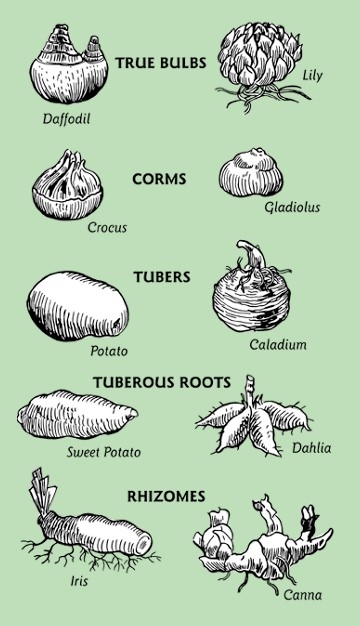By Carolyn Faulkner, Butte County Master Gardener, November 25, 2016.
For many gardeners, fall brings with it the excitement of selecting and planting spring-flowering bulbs.
The term “bulb” is commonly used to describe a wide range of plants that have underground structures in which they store their nutrient reserves. These reserves allow bulbs to survive and bloom from year to year, if conditions are right. Knowing the differences among the five bulb types can help you determine when and where to plant them.

The second type of bulb is the corm. Corms are actually stems modified for storage. These look like true bulbs but they do not grow outward in circular rings. Some have a furry covering and all are solid on the inside. Young buds, which will produce the stems and flowers, form on the topside of corms; roots and cormels (baby corms) emerge from the bottom. The Water Chestnut provides a good example of what the inside of a corm looks like. Flowering corms include gladiolus, crocus, freesia, and watsonia. The water lily is also a corm.
The third type of bulb is the rhizome. These have elongated underground stems which sometimes emerge above the soil surface. Some of these stems are thick, while others are the thickness of a blade of grass, but all produce leaf growth from the top, and roots that emerge from the underside. Examples of rhizomatous bulbs are bearded iris, cannas and calla lilies. The cattail is a rhizome. Unfortunately Bermuda grass and mint are also rhizomes, and their small underground stems allow them to spread easily and become invasive.
The fourth type of bulb is the tuber. Tubers are also underground stems, but not the base of the stem as in a corm. Tubers have multiple “eyes” (buds) and most of them prefer filtered sun. The potato and yam are tubers. Begonias, cyclamen and anemones are all examples of flowering tubers.
The fifth type of bulb is the tuberous root. These are roots that form around a central stem. The sweet potato is a tuberous root which is where it differs from the yam. Some examples of flowering plants that have tuberous roots are dahlias, agapanthus and day lilies.
The depth that each bulb is planted varies according to the type: some (like rhizomatous bearded iris) can be planted just below the surface, while others (like tulips) require deep planting of up to eight inches. Because bulb depth varies so widely, it is important to check sources before planting, but the general rule of thumb for plantingspring bulbsis toplant two to three times as deep as the bulbis tall.
Bulbs to plant in the fall for late winter and spring blooms include tulips, daffodils, crocuses, Dutch iris, and many types of lilies. Bulbs to plant in the late winter and early spring for summer flowers include dahlia, canna, begonia, and gladiolus. Light fertilizer can be applied just as the bulbs begin to grow.
Most bulbs like full sun, but there are some exceptions, such as hyacinthoides (bluebells) and many daffodils, which bloom in early spring before trees leaf out.
Most bulbs are perennials, and many do well in containers. Most bulbs prefer well-drained soil, but exceptions include the Summer Snowflake (Leucojum), Camassia quamash, and Lilium lancifolium (the orange tiger lily), cattail and (of course) the Water Lily, all of which like damp, even soggy, conditions.
Once bulbs have bloomed, do not cut back their leaves until they have turned yellow and are obviously dead. The bulbs require these leaves to manufacture carbohydrates and store energy for the next year, through photosynthesis. However, the flower stalks can be cut back to where the foliage begins. It is important to apply a complete fertilizer after bloom in the spring, spreading around the base of the leaves, and to continue minimal watering. Once leaves have been removed the bulb can be dug up and stored in a dark dry cool place or simply left in the ground. Be careful not to over-water. Unless your bulbs are among the water-tolerating exceptions, too much water will cause the bulbs to mildew or rot.
A helpful chart for bulb planting can be found at Sacramento Bulb Planting Schedule. Keep in mind, however, that our Butte County winters tend to be colder than those in Sacramento.